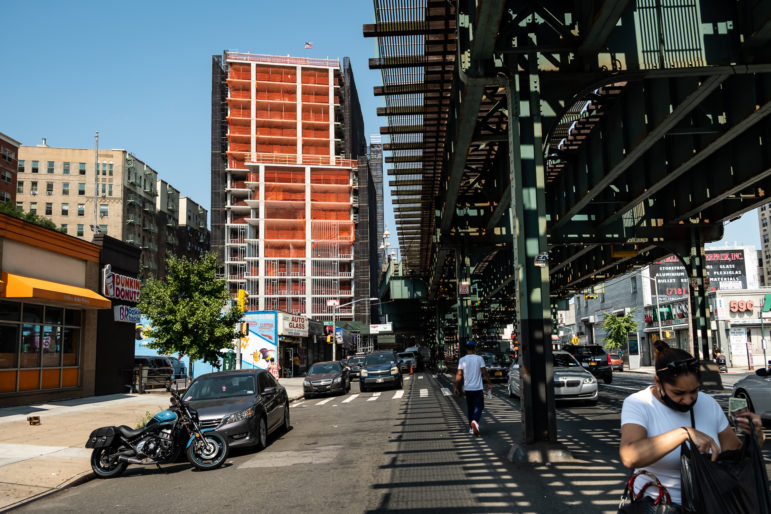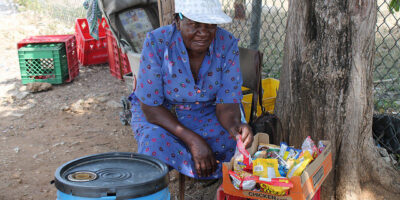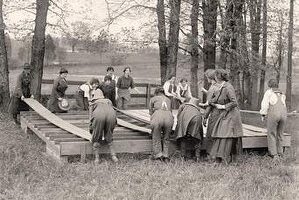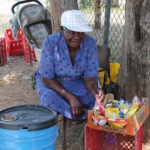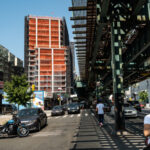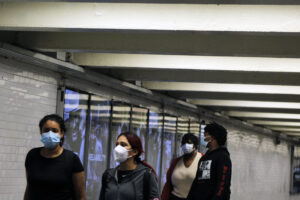Marlon V Bailey
Professor Michael Johnson
URB PADM 601
20 December 2021
In Queens, lifelong residents of New York’s most diverse borough are seeing the Tidal Wave of gentrification, neighborhoods such as Jamaica, Flushing Queens, Long Island City, Lefrak City, and Elmhurst are some of the neighborhoods affected by this Tidal Wave. And although gentrification proponents are claiming it will benefit these communities, that need commercial developments, opportunities for residents, lower crime rates, and an increase in property values. We must also look at the drawbacks of gentrification such as rent increase, the availability of affordable housing for the original residence, and the fact that these neighborhoods are usually occupied by poor working-class minority groups such as blacks, Hispanics, and Asians. This isn’t a concern for the New York Economic Development Corporation (NYCEDC), building developers, bureaucrats, and politicians, because they have decided to work behind the scenes in their attempt to ram more than a dozen luxury buildings down the throats of the original residents by skipping the legally mandated parts of the city’s land-use review process in order to rubber-stamp all of these NewYork City’s building projects regardless of the displacement of these residents, according to Queensgentrification.org. Dual Power. 2019. 17 Dec. 2021 “The EDC, and other public-private partnerships are tools used by corporations and the wealthy to shape the development of our city in their interest, without accountability or transparency” Queensgentrification.org.

Their argument is the benefits of gentrification out weight the drawbacks and that on the positive side it leads to commercial development in impoverished communities, improve the economic opportunities of the residents, lower the crime rate, and increase the property value of existing residents and the residents who remain in these gentrified neighborhoods usually shared in the benefits, due to the poverty rate around them dropping to around 7 percent. This is due to a more desirable neighborhood and a better place to live in, an increase in the natives’ wealth and equity, and the ease they could sell their if they desired to do so. But the drawbacks of gentrification are more substantiated than the benefits because it is one of the major catalysts leading to homelessness, unnecessary cultural displacement, rapid rent increase, it can sometimes make a community poorer, replace the people who build the community, change the existing culture of the neighborhood, make the rich get richer. And the negative health benefits are and other factors, such as higher cancer rates, birth defects, greater infant mortality rate, and the increased cases of asthma, diabetes, and cardiovascular diseases due to the lack of access to affordable healthy housing, healthy food choices, transportation choices, quality schools, access to amenities such as bicycle and walking paths, exercise facilities and social networks. “The Other Side of Gentrification. 2004. 17 Dec.2021 “This becomes evident in health outcomes such as cancer rates, the incidence of asthma, diabetes, and cardiovascular disease, as these marginalized residents are often priced out of neighborhoods with healthy housing, healthy food, and healthy urban environments” livablecities.org”. So, what is the NYEDC role in this? Their role is simple because all so-called economic development and gentrification fall under their jurisdiction and is responsible also for leveraging the City’s assets to create good jobs, drive growth, and ensure equitable development across all the five boroughs. Being the quasi-public agency that manages the funds generated by properties and land owned by New York City, including Hunts Point.
NYCEDC is regarded as a nonprofit organization consisting of a board appointed by the Mayor, Borough Presidents, City Council Speaker, and Community Boards of New York. And in such is their multiple purpose tool, used for coordinating private entities building activity projects all across New York City. They also have the authority to grant tax breaks and subsidies in exchange for job creation, which cost the city $ 1.6 billion annually. But their failure is now being highlighted by senator Julia Salazar who stated “The city and state can sustain projects that can support a healthy local economy without supporting bad economic development projects and enormous tax subsidies for corporations, as the EDC does”. This is the first step in reclaiming NewYork City from NYEDC gentrification and the displacement of its most vulnerable residents minority groups, blacks, Hispanics, low income, and the poor and begin to cut the city contract with the EDC and consolidate its resources and holding under the control of the city government Stanford News. Sander Feder. “determine that the negative effects of gentrification are felt disproportionately by minority communities, “Gentrification Disproportionately Affects Minorities.2020. 17 Dec.2021 https://news.stanford.edu/2020/12/01/gentrification-disproportionately.
The NYEDC gentrification of non-white neighborhoods in New York City favors wealthy building investment entities, such as luxury hotel franchises, Disney, etc., by not assessing their property taxes conventionally, but by payment in lieu of taxes (PILOTs). This allows the NYEDC to capture public funds before they are managed democratically and allow the wealthy building entities to underpay the city for a valuable property that rises in value and get away with only paying the city a flat rate all the while making millions, sometimes billions after gentrifying NewYork City’s government disinvested communities. This can be regarded as corporate welfare and do all this under the disguise of economic development, community development, and job creation Richardson et al. Gentrification and Disinvestment 2020.2020.17Dec. ncrc.org “ Their Problem was stagnation and disinvestment, not gentrification”.
The NewYorkEconomic Development Corporation (NYEDC) was formed in 1991 as the result of merging two major not-for-profits and a small number of minor corporations together. This included the Public Development Corporation (PDC) that was formed in 1966 in the effort to rescue the city from its economic extinction, by selling City properties and leasing industrial space. Building projects include Nassau Street Mall, Brooklyn Army Terminal, Jamaica Center and South Shore Sea Port, etc., Continuing the NYEDC formation, the second major partner was included, the Financial Services Corporation ( FSC) that was formed in 1980 to manage and finance programs promoting business expansion in NewYork City. Which followed the recommendations of the consulting firm of McKinsey and Company, the firm task with the reorganization of the New York development system since 1990. Seven of it members are appointed by the Mayor of New York City, including the chairperson, other members by the Borough President Presidents, and the Speaker of the New York City Council NYCEDC. Homepage. 2015. 17 Dec.2021 “The de Blasio administration today announced the appointment of ten new members to New York City Economic Development Corporation’s Board of Directors”.
Race and the neighborhood’s crime rate determine why gentrification by NYCEDC is implemented in neighborhoods occupied by black and Latinos and other non-white ethnic groups. Gentrification has been happening since 1970, preferable in multi-ethnic neighborhoods, that have struggled economically. The implementation of racial inequality neighborhood gentrification by the NYCEDC and NewYork City’s political representatives are the result of urban policies crafted by NewYork state and city government, without the interest of non-white ethnic groups in mind and due to our political representative’s reliance on this neighborhood gentrification to revitalize NewYork City’s economy, by gentrifying economically stressed neighborhoods, by catering to wealthier, better educated, and higher-income earners white Americans. That further isolated poor blacks, Latinos, and other non-white ethnic groups, thus creating racial inequality and segregation. Twenty-Sixteen was the year one -third of low-income residents in gentrified neighborhoods living in low-income neighborhoods were displaced by gentrification by the NYEDC and over 12 percent of neighborhoods in NewYork City was in the advanced state of gentrification, facilitated by high income, highly educated new residents, with NYCEDC gentrification agenda created disinvested neighborhoods displacement. With nine percent experiencing displacement, not caused by gentrification. They are 314 super-gentrified neighborhoods by NYCEDC in the metro region that are high-income suburban and exurban created communities existing all around New York City gentrified by NYCEDC since 1990-2021. These low-income communities occupied by African Americans, Latinos, and other ethnic minority groups transformed into high income-communities with the median income being 140,000, which is 200 percent of the median income in these communities. Therefore, income disparity is the speedway to gentrifying neighborhoods occupied by the poor, working-class, and non-white ethnic groups Urban Displacement Project. Homepage Sept.2016. 17 Dec. 2021 < https://www.urbandisplacement.org> “Neighborhoods are categorized as exclusionary when rents are so expensive that low-income people are excluded from moving in another form of displacement”.
This is indicated by the urban displacement map census track level, the organization that gathers information on urban displacement shows that 10 percent of neighborhoods with low-income residents per hold reaching about 550,000 are on the cutting block of getting gentrified, based on the availability of affordable housing and the vulnerability of residents, income, education, race, and ethnicity. The urban displacement maps also identify black, Latinos, and other minority groups that lack the signs of government input and investment. This highlights the application of NYCEDC and New York City’s Government neglect and pressure that is felt in many Queens neighborhoods and throughout New York City, the importance of affordable public housing, housing subsidies, and diversity in all gentrified neighborhoods. This shows the importance of policymakers, NYCEDC, and community-based organizations working together on displacement and gentrification issues. By creating data that allows them to understand the long-term effects of gentrification. The irony in all this is that poor neighborhoods once gentrified become wealthier neighborhoods with better amenities and economic stabilities. In 2004 Professor Lance Freeman stated that NewYork is one of the cities, that residents pay the highest amount of their income on rent and real estate purchases.” According to a study done by Zillow Real Estate research between 2000-2014, the median household income rose 25% while rents increased by 53%”. Highlighting this is relevant in showing the negative effects that occur when the NYCEDC facilitate gentrification in blacks, Latinos, and other minority neighborhoods and the research shows that the displacement caused by gentrification, occurs at a higher rate if families are poor and low-income and eventually are replaced by wealthier and higher-income families. queensantigentrification.org.Homepage. 27 Mar. 2020. 17 Dec.2021 <queensantigentrification.org> “The EDC and other public-private partnerships are tools used by corporations and the wealthy to shape the development of our city in their interest”
NewYork City Economic Development Corporation and New York’s political representative seems to think gentrifying neighborhoods is the conduit to the city’s reconstruction, so they authorize building development renovation projects using the disguise of, it creates jobs for low-income residents and also financial investment in the economic development and infrastructure of NewYork City, lower crime rate, better services, and amenities, hinting that gentrification provides better security and improve the gentrified community. But the problem with gentrification in New York is based on three classifications. The race is the first step taken to authorized rezoning and redesigning neighborhoods that are tagged to be gentrified. The second class is the second step used to upscale the neighborhoods and property value that in turn attract wealthy and high-income earners. This would price out low-income families, increase property value and create higher tax revenues and allow the third step of gentrification to take place. This indicates the reason why NYCEDC orchestrates gentrification, is to give away millions of taxpayers’ dollars to wealthy developers, generate tax revenue for governmental municipalities, and displacement of low-income families that cannot afford the higher cost of living in their new gentrified neighborhoods, that they live for decades. In closing I realized that NYCEDC gentrification of ethnic minority neighborhoods only benefits the wealthy, not the poor, low-income, and working-class, It destroys lives, communities, the culture of the communities gentrified. I also realized that the Mayor, Borough Presidents, City Council Speaker, Communities Boards, and NYCEDC, with the aid of our many political representatives, are determined in their quest to revitalize neighborhoods, occupied by non-white ethnic groups. Who are never invited or included in the conversation of their neighborhood revitalization planning, or their concerns were taken seriously? Gentrification and how it affects the original native should be included not an exclusion for the poor,low-income, blacks, Hispanics, and other minority ethnic groups, that deserve the right to continue living in their neighborhoods without being priced out.
Work Cited
https://queensantigentrification.org/
https://news.stanford.edu/2020/12/01/gentrification-disproportionately-affects-minorities/
https://ncrc.org/gentrification20/
https://www.livablecities.org/blog/other-side-gentrification-health-effects-displacement
https://edc.nyc/press-release/mayor-de-blasio-appoints-new-members-nycedc-board-directors
https://www.urbandisplacement.org/maps/new-york-gentrification-and-displacement/
